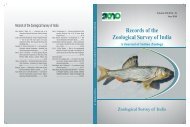Vol. 111 - Part I - Zoological Survey of India
Vol. 111 - Part I - Zoological Survey of India
Vol. 111 - Part I - Zoological Survey of India
You also want an ePaper? Increase the reach of your titles
YUMPU automatically turns print PDFs into web optimized ePapers that Google loves.
SANYAL et al. : The Jackals <strong>of</strong> Tollygunge Club, Kolkata 43<br />
Table 2. Statistical details <strong>of</strong> Jackals counted in Tollygunge Club.<br />
Observer Male Female Juvenile Indeterminate Total Instance Single<br />
1 2 1 0 2 5 3 1<br />
2 5 5 1 11 8 5<br />
3 6 4 2 2 pups 14 8 5<br />
4 6 6 1 13 8 5<br />
19 16 4 2 + 2 43 27 16<br />
mostly located in the bushes in the eastern periphery<br />
<strong>of</strong> the club while one active den with two cubs was<br />
observed in the centre <strong>of</strong> southern half <strong>of</strong> the club.<br />
Their locations are marked in the Map 1.<br />
iii) Carrying Capacity<br />
In a natural environment the hunting families hold<br />
territories <strong>of</strong> two to three square kilometers throughout<br />
the year, portions <strong>of</strong> which are marked with urine, either<br />
by the male or the female jackal, to ward <strong>of</strong>f intruders.<br />
However, the study area (Tollygunge club) with only<br />
100 hact. (1 sq km.) in area holding a handsome, healthy<br />
and breeding population <strong>of</strong> jackals is an indication that<br />
the carrying capacity <strong>of</strong> the club in terms <strong>of</strong> its food<br />
supply is still in favor <strong>of</strong> jackals. During the period no<br />
fighting was observed, demonstrating defending <strong>of</strong><br />
territory.<br />
iv) Interspecific Behavior<br />
It was observed that the basic social unit <strong>of</strong> the<br />
golden jackal is a mated pair or a mated pair and its<br />
young. The jackals were observed to forage and rest<br />
together. While in natural conditions pairs/pack are more<br />
likely to be successful in hunting in comparison to<br />
individuals they have been observed foraging on small<br />
animals in a group despite the fact that in current case<br />
hunting larger prey is out <strong>of</strong> question.<br />
Most jackal families were observed to have helpers<br />
which are subordinate to parents. In the wild habitat<br />
these helpers are probably responsible for reports <strong>of</strong><br />
large packs hunting together but in present case, in<br />
absence <strong>of</strong> such purpose, these associations are, it<br />
seems part <strong>of</strong> their habits.<br />
DISCUSSION<br />
The jackal population <strong>of</strong> Tollygunge Club has been<br />
studied earlier by Dr. A. K. Ghosh and others<br />
(unpublished report) and a few students from<br />
Vivekananda College, Kolkata. However, the current<br />
assignment was given to us to principally study<br />
population, food habits, inter-specific behavior and<br />
health <strong>of</strong> the occupants.<br />
Primarily, what we find is that the jackal population<br />
<strong>of</strong> Tollygunge Club has adapted to their surroundings<br />
and display quite a different behavior from their cousins<br />
found in the wild. The most important adaptation is<br />
their diurnal habits and uncared attitude towards human<br />
beings. The most suitable explanation to it, seems, that<br />
both man and animal has accepted each other as they<br />
are there since last so many years. Historically also,<br />
there are no records <strong>of</strong> jackals posing any threat to<br />
humans except perhaps in the rare occasion when it is<br />
affected by rabies.<br />
The transect method <strong>of</strong> census, applied for area is<br />
most appropriate method with relatively open terrain <strong>of</strong><br />
the club, yielded reliable results. The present population<br />
<strong>of</strong> jackal in the club may be in the range <strong>of</strong> 40-45<br />
individuals. This is not the total count and only an<br />
estimate. However, it requires more time and equipments,<br />
like capture and marking devices, to know the exact<br />
number <strong>of</strong> jackals in the club premises. The party<br />
conducted survey earlier (Ghosh, et al 2008) has sighted<br />
only 14 jackals. The recording <strong>of</strong> as high as 30% <strong>of</strong> the<br />
population (16 animals) as singles’ is the indication that<br />
the jackal groups in the Club area are not as cohesive<br />
as in the wild. The possible explanation to this may be<br />
that they consider more secured within the premises<br />
and consistent groups are formed during breeding and<br />
rearing period.<br />
The basic social unit <strong>of</strong> the golden jackal is a mated<br />
pair or a mated pair and their young (helpers). They<br />
forage and rest together. Though it was difficult to draw<br />
any dividing line between the groups the total
















